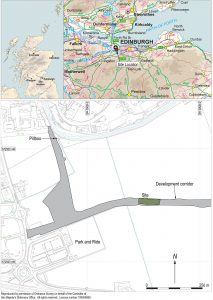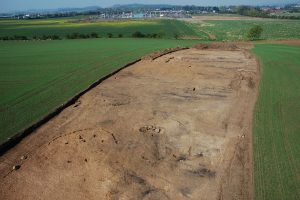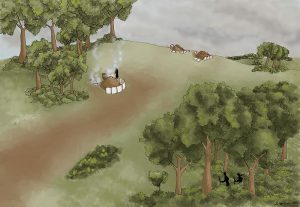 Recently published research by Bob Will of GUARD Archaeology reveals the discovery of the complex history of settlement at a place in the Lothians of Scotland, from the Neolithic through the Bronze Age and Iron Age into the early medieval period.
Recently published research by Bob Will of GUARD Archaeology reveals the discovery of the complex history of settlement at a place in the Lothians of Scotland, from the Neolithic through the Bronze Age and Iron Age into the early medieval period.
This work was undertaken at Gogar Mains to the west of Edinburgh in advance of the construction of the Edinburgh Tram Scheme linking Edinburgh Airport with the city centre. Prior to the excavation several prehistoric archaeological sites were known in the immediate vicinity including cropmarks of two possible settlements. Within the wider locality, there is a wide range of known sites, including to the north the ‘Cat Stane’, with its early medieval Romano-British latin inscription and associated long-cist cemetery, as well as prehistoric remains consisting of Neolithic pottery and flint tools. There are also references to another long-cist cemetery to the south while further to the north is the Craigie hillfort and to the west is Huly Hill, an early Bronze Age mound and Iron Age Chariot burial as well as a medieval settlement.

The excavation was initially centred on the concentration of archaeological features revealed during an earlier evaluation. Once the topsoil was stripped, over 150 features were investigated, revealing seven discrete areas of activity that contained a range of botanical and artefactual evidence and radiocarbon dates that demonstrate that the site was in use over a long span of time between the early fourth millennium BC and the eighth century AD.
Neolithic activity was represented by pits containing hazel nutshell, flint tools and pottery sherds from carinated bowls, probably the debris from a Neolithic settlement. More clearly defined evidence for a house structure was apparent in the Bronze Age, in the form of a ring groove with internal post-holes, adjacent to a palisaded enclosure but there was little artefactual evidence and the dating of these structure derives solely from radiocarbon dates. These dates suggest two phases of construction or use of the palisade. There was little evidence for structures within the palisade, although several post-holes may indicate an internal supporting structure, or fence lines indicative of pens for livestock.
 Two truncated roundhouses near the north end of the site were dated to the Iron Age. An associated fragment of a miniature quern was recovered; these tend to be found in the east of Scotland during the Iron Age. The final phase of activity on-site comprised the remains of two corn-drying kilns, dated to between the sixth and eighth centuries AD, that survived as oval pits containing considerable quantities of burnt and charred cereal grains. Associated with the better-preserved kiln was a rim sherd of coarse pottery and two fragments from a rough quern.
Two truncated roundhouses near the north end of the site were dated to the Iron Age. An associated fragment of a miniature quern was recovered; these tend to be found in the east of Scotland during the Iron Age. The final phase of activity on-site comprised the remains of two corn-drying kilns, dated to between the sixth and eighth centuries AD, that survived as oval pits containing considerable quantities of burnt and charred cereal grains. Associated with the better-preserved kiln was a rim sherd of coarse pottery and two fragments from a rough quern.
 While the archaeological investigations provided evidence for occupation of this place over a long period of time, it was surprising that little evidence for settlement from the Roman occupation of southern Scotland was encountered, considering the presence nearby of a Roman fort, milestone and temporary camps. The archaeological remains from the excavation nevertheless provide a palimpsest of prehistoric and early medieval occupation and support similar occupation and settlement evidence from the wider region. The early medieval date for the corn-drying kilns provides direct evidence for settlement and agriculture, as well as a domestic setting for the long-cist cemetery at Catstane to the north. Together with another nearby long-cist cemetery to the south and contemporary field boundaries near Gogar Church, the results are combining to gradually fill out a picture of sustained settlement and agriculture in this area of the Lothians during the early medieval period.
While the archaeological investigations provided evidence for occupation of this place over a long period of time, it was surprising that little evidence for settlement from the Roman occupation of southern Scotland was encountered, considering the presence nearby of a Roman fort, milestone and temporary camps. The archaeological remains from the excavation nevertheless provide a palimpsest of prehistoric and early medieval occupation and support similar occupation and settlement evidence from the wider region. The early medieval date for the corn-drying kilns provides direct evidence for settlement and agriculture, as well as a domestic setting for the long-cist cemetery at Catstane to the north. Together with another nearby long-cist cemetery to the south and contemporary field boundaries near Gogar Church, the results are combining to gradually fill out a picture of sustained settlement and agriculture in this area of the Lothians during the early medieval period.
The full results of this research, which was funded by the City of Edinburgh Council, Excavations to the West of Gogar Mains, Edinburgh by Bob Will with Heather F. James is freely available to download from the Scottish Archaeological Internet Reports website, published by the Society of Antiquaries of Scotland.
